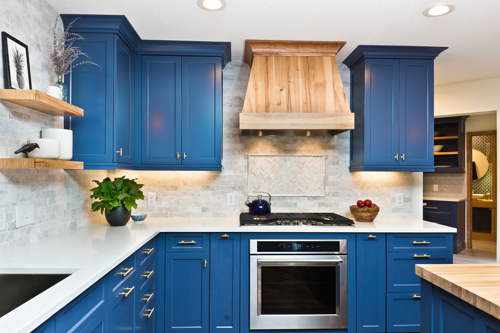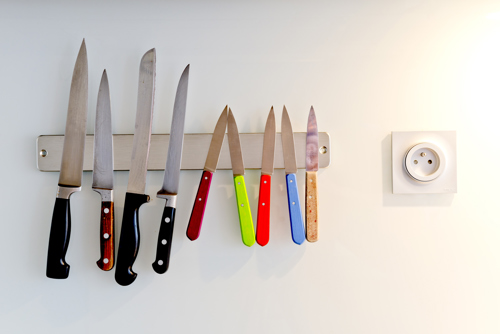A cluttered kitchen can be a major eyesore, especially if the space is tiny to begin with. Whether it’s a counter heaped with stand mixers and spices — or a pantry that always seems too crowded — simply tossing items out won’t necessarily solve your issues with space. (We get it — you might not be cooking all the time, but takeout cartons still need a place to rest!)
In fact, all your small kitchen storage issues may boil down to where you’re keeping your appliances and ingredients — and the way you’re optimizing every surface, cubby and wall to ensure that your surfaces are clear and that your most-used items are easily accessible. Read on for our best small kitchen organization ideas to give you ample room to prep your meals.
1. Keep Your Counters Clear
This may seem like a no-brainer, but avoid using your counters as storage. While it’s easy to let mail, fruits, salt shakers, oil bottles and appliances pile up, too many objects will only detract from the primary purpose of a counter: your cooking workspace.

Finding a new home for any stray or lingering items will make surfaces quicker to clean and give your kitchen a more open, spacious appearance.

2. Hang Knives From a Magnetic Rack
Bulky knife blocks take up valuable counter space. In a small apartment or compact kitchen, there are better ways to store your steel. With a magnetic strip, strong glue, and a few other cheap hardware purchases, you can make a DIY magnetic knife strip to free up your surface and keep your blades close at hand. You can also buy an affordable set online and follow the manufacturer’s instructions to set it up.

3. Hang Your Pots and Pans (or Store Them on the Stovetop)
Instead of jamming up a pantry shelf or cabinet with your pots and pans, consider floating them on a sturdy overhead pot rail or pot rack. Since setting up a pot rack involves installing it into the support beams of your ceiling (rather than simply screwing them into the drywall), you’ll need to be savvy with drills, wall toggles and other tools to do it correctly. If you’re not ready to commit to a hanging solution, you can use a burner on your stovetop — or even the top of your fridge — as a resting spot for your cookware.

4. Put Your Vertical Space to Work
Vertical space — walls, the sides of your fridge, the inside of a pantry or cabinet drawer — are prime real estate for some of your kitchen ingredients and tools. You can affix compact and discreet cubbies to your lower cabinets to store things like oil and vinegar bottles or your all-star spices and bulk items. Storage solutions like pegboards (a favorite of legends like Julia Child) are a versatile way to hang everything from pots and pans to whisks, mugs, graters and more.

5. Transfer Snacks and Grains to Bins or Mason Jars
If you buy bulk items like rice, flour, sugar and other staples, you can streamline your space by simply pouring them into uniform containers and Mason jars. Food storage containers like these are not only airtight (to keep your food fresh and increase their shelf-life), but stackable. They’re durable and clear — meaning you can see what you’re grabbing — but you can stick an erasable label on them as well.

6. Add New Space With Islands
If your kitchen has an empty corner or a bit of unused space, consider fitting an island as a bookend or stand-alone piece. A kitchen island can be a multipurpose platform for your microwave or coffee maker, and often comes with built-in shelving where you can store your cutting boards, cookbooks, hand towels, and other miscellaneous items. You can even use it to prep food if your counter doesn’t offer enough space.

7. Get Creative With Your Drawers
Your drawers are likely where you dump your utensils and hand towels, but a bit of strategy can transform them beyond a toolshed. For instance, rather than keep your spices on a sunlit counter or near the stove (where heat can quickly turn them rancid), line a few chic plastic inserts side by side in a drawer to create your very own spice jar organizer. If you have any bulky utensils like whisks or ladles, avoid sticking them in a drawer, where they’ll take up precious space, and hang them on a pot rail or pegboard instead. The best way to tidy up your drawers is to start from scratch: clear them out, organize by type (whether it’s cutlery, serving platters, cutting boards or more) and assign them to drawers with add-in shelving.
8. Put Seasonal Items in Storage
If you have large kitchen items you anticipate using seasonally — like a juicer or holiday dishware — consider stowing them outside of your home. You can keep such as items safe by keeping their original shipping boxes, wrapping them up in a sheet or towel, or using coffee filters, bubble wrap and other forms of padding to prevent fragile items from breaking.









